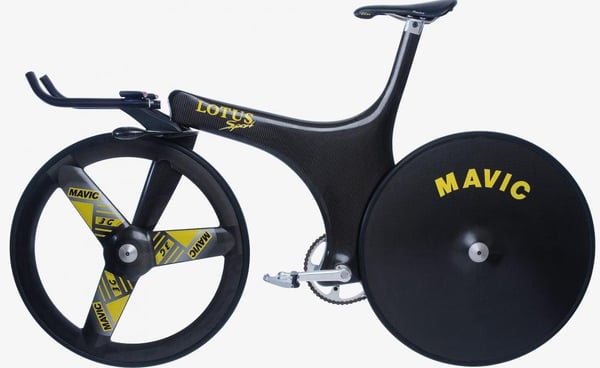

Chris Boardman, born 26 August 1968, is an English racing cyclist, who won the individual pursuit Gold medal at the Barcelona 1992 Summer Olympics, winner of the inaugural men's World time trial championship at Catania, Italy in 1994, a three times holder of the World hour record and a holder of the yellow jersey at the Tour de France on three occasions.
Educated at Hilbre High School in Wirral, Merseyside, (the same school as actor Daniel Craig of James Bond fame) his first bike race was at the age of 13, By 16 he was a member of the national cycling team.
Boardman won his first national time trial in 1984 and broke the junior 25-mile national record again in 1984, by 1986 he was the holder of the junior 25 mile championship.
As a senior he held consecutive hill climb championships from 1988 to 1991, 50-mile championships 1991 to 1992, broke the record
Boardman used the Lotus 108 TT bike designed by Bike Burrows and built by Lotus cars, he went on to work with Hotta, a Carbon bike specialist firm to produce other TT frame designs.


Obree has created some radical innovations in bicycle design and cycling position but had problems with the cycling authorities banning the riding positions his designs required.
He built the frame for his bike in his own shop and made Instead of traditional dropped handlebars, straight bars like those of a mountain bike. but much shorter, He placed them closer to the saddle than usual and rode with the bars under his chest, his elbows bent and tucked into his sides like those of a skier. Watching a washing machine spin at 1,200rpm led him to take the bearings, which he assumed must be of superior quality, and fit them to his bike. Obree later regretted admitting to the bearings experiment, because journalists referred to that before his achievements and other innovations.
Obree called his bike "Old Faithful". It has a narrow bottom bracket, around which the cranks revolve, to bring his legs closer together, as he thought this is the "natural" position. As shown in the above image the bike has no top tube, so that his knees did not hit the frame. The chainstays are not horizontal to the ground. Thus the cranks can pass with a narrow bottom bracket. The fork had only one blade, carefully shaped to be as narrow as possible. A French writer who tried it said the narrow handlebars made it hard to accelerate the machine in a straight line but, once it was at speed, he could hold the bars and get into Obree's tucked style.
The world governing body, the Union Cycliste Internationale, grew concerned that changes to bicycles were making a disproportionate influence to track records. Among other measures, it banned his riding position: he did not find out until one hour before he began the world championship pursuit in Italy. Judges disqualified him when he refused to comply, the magazine Cycling Weekly blamed "petty-minded officialdom.
Obree developed another riding position, the "Superman" style, his arms fully extended in front, He also bolted his shoes to the peddles to minimise the risk of his feet slipping at high torque and he won the individual pursuit at the world championships with this and Old Faithful in 1995.That position was also banned.


However, in May 2014 the UCI relented, acknowledging that fixing the kind of equipment to be used was hindering technical progress. It restored previous banned world records, from 2000, now to be described as "Best hour performance".
16th July 1993 Obree attacked Moser's record at the Vikingskipet velodrome in Norway. He failed by nearly a kilometre, he had booked the track for 24 hours and decided to come back the next day. The writer Nicholas Roe said: to stop his aching body seizing up, Obree then took the unusual measure of drinking pint upon pint of water so that he had to wake up to go to the lavatory every couple of hours through the night. Each time he got up, he stretched his muscles.
On the next day, he was up and out within minutes, at the deserted velodrome by 7:55 am and on the track ready to start just five minutes after that. He had barely slept. He had punished his body hugely the previous day.
Obree said: I was Butch Cassidy in terms of swagger. I didn't want any negativity. This was blitzkrieg. I'm going in there. Let me do it. I'm not going to be the timorous guy from Scotland. That's what the difference was. Purely mental state. The day before, I had been a mouse. Now I was a lion.
On 17 July 1993, Obree set a new record of 51.596 kilometres, beating Francesco Moser's world velodrome hour record of 51.151 kilometres by 445 metres, Its worth noting that Moser's record lasted for 9years and was set in Mexico City at high altitude, aided with blood transfusions (not banned at the time).
Qbree's record was achieved at sea level but lasted less than a week. On 23 July 1993, the British Olympic champion, Chris Boardman broke Obree's record by 674 metres, riding 52.270 km at Bordeaux. His bike had a carbon monocoque frame, carbon wheels, and a triathlon handlebar. Their rivalry grew: a few months later Obree knocked Boardman out of the world championship pursuit to take the title himself.
The original Old Faithful bike is on display at the National Museum of Scotland in Edinburgh, while two near-replicas built for use in the Flying Scotsman film are displayed in the Riverside Transport Museum in Glasgow.In March 2018,


Chris Boardman